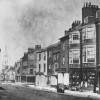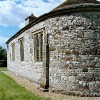An event 223 years ago, when it became the summertime resort of a king, converted an already popular seaside resort on the Dorset coast into a world-renowned watering place, now one of the most popular in England among holidaymakers. KING GEORGE III came to Weymouth to convalesce in 1789, and returned many times over the next 16 years. He bathed in the sea every morning, from a bathing cart, a copy of which can be seen at Weymouth Museum. No other bathers were allowed in the vicinity.
Gloucester Lodge was built on the seafront in 1780 and was to become the summer palace of the King. Adjoining the Gloucester Hotel, the lodge has suffered from fire but has now been rebuilt – and is now lived in by flat-dwellers. But though now regarded in a matter-of-fact manner, the King who brought prosperity and encouraged Georgian architecture is not forgotten. A statue to George III was erected in 1809 by the inhabitants on a traffic island in the centre of the Esplanade, where Weymouth’s benefactor could not be forgotten, and past which frequent stagecoaches carried visitors to the town. The statue and its accompanying emblems are still repainted every year in vivid colours.
George III suffered from what has been described as an imbalance of body chemicals damaging the nervous system. George III was to make his 14th and final visit in 1805, and spent his last years as King confined to Windsor Castle. By the early 19th. Century Weymouth was garrisoned with 10,000 troops billeted in three huge barracks, including a whole regiment on the esplanade. The King had brought everlasting fame as the country’s most fashionable resort to Weymouth; the Army in force – and the highest rents and food prices ever.
It was during George III’s first visit that the storming of the Bastille in Paris took place, at the beginning of the French Revolution. At the time, he was cruising in the Bay. In 1793 France declared war on England. By 1794 there was real fear of an invasion of this country, so that every year saw more and more troops around Weymouth, in addition to the local volunteer forces. The King personally supervised the planning of defences on the Island of Portland. But a projected breakwater, which was to protect the harbour of Portland, was not to be built for over 50 years. In 1798 came the Battle of the Nile and Admiral Nelson’s victory, celebrated with gun salutes on board ships in the Bay and by troops and crowds on the beach.
There is a story that General Garth, a royal equerry, was the father of a baby boy said to have been born in the town to Princess Sophia (22), the King’s fifth daughter, and that he later brought him up at Puddletown. And the famous clown Joe Grimaldi once recited, at the town’s Theatre Royal, an eight-verse poem extolling Weymouth and George III. Terraces were built with regal names. In 1799 the “Sherborne Mercury” declared that Weymouth “had seldom heretofore had to boast of a greater assemblage of rank, beauty and fashion than at present….”
The King rode to hounds, and visited countryseats such as Lulworth Castle, Sherborne Castle and Milton Abbey. He took a great interest in the island of Portland, dined at what is now the Royal Portland Arms – and studied sheep farming. He visited the theatre in Augusta Place, and the Assembly Rooms, and services in the parish church and aboard ship.
In the 1790’s, the King met Mr. Weld of Lulworth Castle and asked him what had happened to the English Catholic communities, which had been set up in the Low Countries. When he was told that nuns at a convent in Belgium where Mr. Weld’s daughter was a novice, had nowhere to flee from the French, and were in danger, he invited the Sisters to come back to their home country. The Sisters sailed from Holland to London and settled in the Abbey House at Winchester where they began to hear Mass.
There were great celebrations when the royal visitor first arrived in town from Windsor, a month after his 51st. birthday, to be greeted by thousands at the Weymouth turnpike, and copious decorations in the streets. On first viewing the Bay, the King enthused: “I never enjoyed a sight so pleasing.” That visit was to last no less than 10 weeks.
According to one report, the King, Queen Charlotte and the Princesses were out in the sea air by six o’clock every morning, and there were frequent voyages on the royal yacht, protected by a ring of frigates.
On the 24th August 1804 George and his entourage set off from Windsor for Weymouth travelling through the night arriving there at dawn. He was soon to be seen walking along the Esplanade and on horseback he reviewed the Hanoverian Legion. Later in the day he inspected other military units including the Weymouth Volunteers.
A busy round of engagements; including two balls, one in celebration of his wedding anniversary, and a review of the fleet give the lie to his doctors diagnosis of madness, at that time at least.
For the crowds who saw him on special occasions, the King was a majestic sight to behold, wearing a sash of crimson-netted silk made by his Queen. The original use of sashes was to carry off the wounded from battle, and when spread out they measured over four feet wide by three yards long.
A building spree at Weymouth began with the construction of Stacie’s Hotel in 1772. Georgian houses and terraces were erected and the Royal Crescent and Charlotte Row made their appearances, and a two-feet-wide esplanade wall as protection against the sea.
The arrival of the Victorian Age was recognised when soon after 1850 Victoria Terrace was constructed, including the present-day Hotel Prince Regent.



